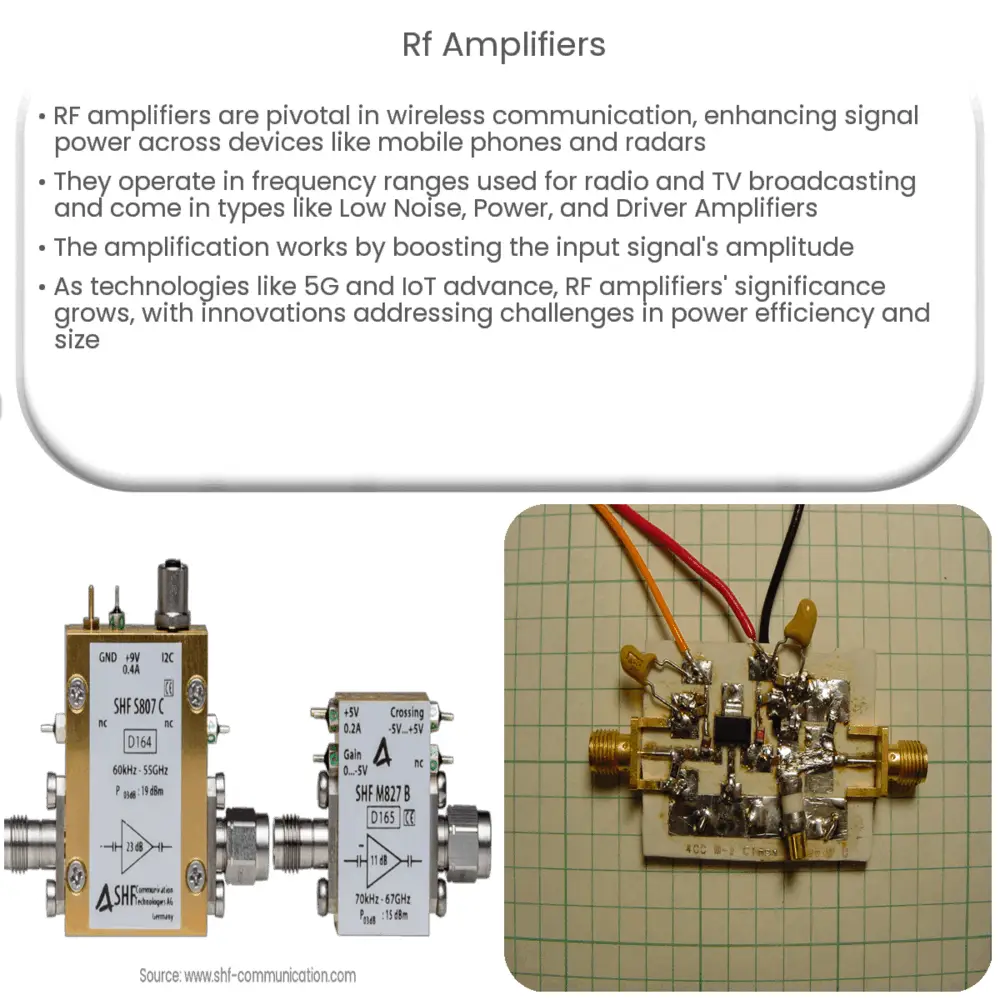Explore the role of RF Amplifiers in wireless communication, their types, applications, and future in this comprehensive guide.

Understanding RF Amplifiers
Radio frequency (RF) amplifiers are an essential component of modern wireless communication systems. They play a critical role in improving the power level of signals in various electronic devices. RF amplifiers operate within the frequency range used for radio and television broadcasting, making them integral to the functioning of these systems.
Types of RF Amplifiers
- Low Noise Amplifiers (LNA): As the name suggests, these amplifiers are designed to amplify signals with minimal additional noise. They are often used in devices like receivers where maintaining the signal’s integrity is paramount.
- Power Amplifiers (PA): Power Amplifiers primarily function to boost the power of a signal, usually for transmission. They are commonly used in transmitters.
- Driver Amplifiers: Driver Amplifiers are intermediary devices that function between a source signal and a power amplifier. They provide initial amplification before the final power amplification stage.
Working of RF Amplifiers
Despite the different types, the underlying principle of an RF amplifier is the same – the amplification of the input signal. The signal received as input is low in amplitude. An RF amplifier increases this amplitude, resulting in an output signal that is stronger than the input signal.
The exact working of an RF amplifier is governed by the laws of electronics and physics. It’s often viewed through the lens of an RF amplifier’s input-output characteristic, which is the relationship between the input signal power and the output signal power. When an RF amplifier is operating in its linear region, the output power increases linearly with increasing input power.
Applications of RF Amplifiers
RF amplifiers find use in a wide range of applications. They are used extensively in wireless and telecommunication devices to enhance signal strength. They are critical components in:
- Mobile phone communication
- Broadcasting services
- GPS devices
- Wireless routers
- Radars
Furthermore, they have a crucial role in satellite communication and radio astronomy, enabling us to receive weak signals from space and turn them into meaningful data.
Considerations When Choosing an RF Amplifier
When selecting an RF amplifier, several important factors come into play. Firstly, the gain of the amplifier, which refers to the ratio of the output signal power to the input signal power, is a vital parameter. Secondly, the operating frequency range of the amplifier must align with the application’s requirements. Other factors such as linearity, efficiency, and output power level also have significant roles in the performance of an RF amplifier.
The Role of RF Amplifiers in Future Technologies
With the rapid advancement of technologies like 5G communication and Internet of Things (IoT), the importance of RF amplifiers continues to increase. These technologies require efficient and reliable transmission of high-frequency signals, thereby demanding high-performance RF amplifiers. Moreover, in the field of space communication and deep-space exploration, RF amplifiers are vital for the reception and transmission of signals over vast distances.
Challenges and Innovations
While RF amplifiers have revolutionized communication systems, they are not without challenges. One such issue is power efficiency, especially in power amplifiers. Improving this efficiency is the subject of ongoing research and development. Moreover, the demand for smaller, lighter devices means RF amplifiers must also shrink without losing their efficiency or power.
In response to these challenges, there have been significant technological advancements. For instance, Gallium Nitride (GaN) based RF amplifiers, known for their high efficiency and power density, are becoming popular. Similarly, advancements in digital signal processing are enabling better control and optimization of RF amplifier performance.
Conclusion
In conclusion, RF amplifiers are a critical component in the landscape of wireless communication, playing an essential role in boosting signal power. Their functionality and versatility span a wide range of applications, from terrestrial communications to space explorations. Despite the challenges associated with power efficiency and size reduction, continuous innovations promise to enhance the capabilities of RF amplifiers. As wireless technology continues to evolve, the role of RF amplifiers is set to become even more significant, propelling us further into the era of seamless, high-speed communication.

